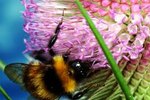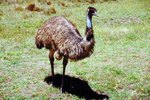
Unlike other insects such as butterflies and houseflies, locusts do not undergo a complete metamorphosis. Although they look a lot like grasshoppers, their swarming behavior in green-favorable habitats makes them different. Locusts go through egg, nymph and adult stages -- lacking the pupa stage. Fledgling is an intermediate stage that occurs between the nymph and adult periods. Their life cycle period varies depending on the species of the locust.
Mating
During mating, the male locust engages in intercourse with a female by inserting the tip of its abdomen into the female’s abdomen opening. In the process sperm is deposited in the female’s oviduct and then stored in a sperm sac awaiting eggs. During laying, the sperm is released from storage to fertilize the eggs as they pass through the oviduct.
Eggs
Female locusts lay eggs in suitable locations shortly after mating -- moist sand soils -- according to Australian Ministry of Agriculture. Female locusts make holes in the soil using their abdomen tip and lay eggs in a pod-like structure shielded by foam. The holes range between 2 and 10 centimeters in depth, according to Real Science. The foam covering secures the eggs from predation, dehydration and contamination.
Nymph
The eggs hatch within 10 to 20 days depending on temperature and moisture conditions. Afterwards the nymphs move to the ground and hop around as they have no wings. They then undergo the five hopper stages, also known as instars. In each successive stage, the nymphs shed their skin to allow further growth. In addition they grow wing buds, which develop to full wings as they approach adult stage. The locusts spend four to eight weeks in the hopper stages and tend to congregate in bands.
Fledglings
Due to the softness of their wings, the final molts of the nymphs are not able to fly, according to Real Science. These flightless young adults are known as fledglings and their wings take at least a week or more to harden. During this stage the locusts consume lots of green food to boost wing development and egg production.
Adults
Characterized by massive movement and feeding, adult is the final stage of the locust life cycle. The locusts at this level have fully pledged wings and can fly without problem. They tend to swarm together in areas with plenty of green feed and are destructive in gardens. They move in large swarms and migrate to new fields on exhaustion of current feeds. They have a lifespan of at most eight weeks during which they reproduce and die.
References
Photo Credits
-
George Doyle & Ciaran Griffin/Stockbyte/Getty Images
Writer Bio
Kendal Elizabeth has been a professional writer and editor since 2001. She has specialized in writing pet-related topics, home decor and gardening. Her work has appeared on several online and offline publication. Elizabeth holds a Bachelor of Science in Animal Science with a minor in marine biology from Cornell University.



